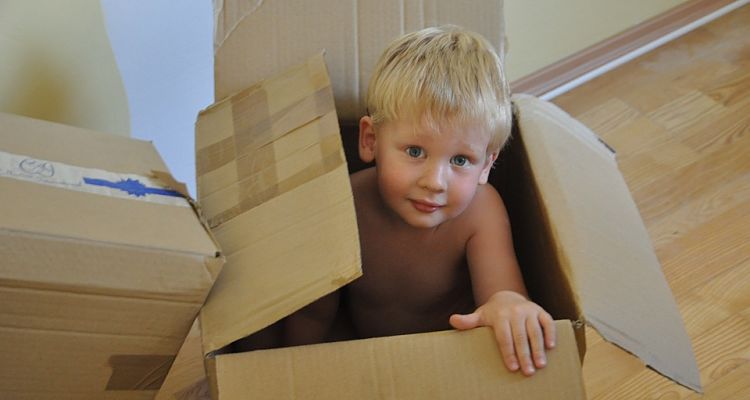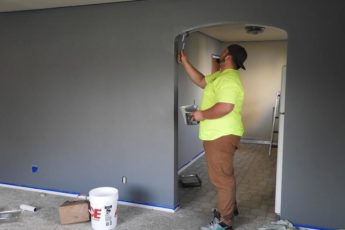
For anyone who has just moved into a new home, there is the very familiar scene of unpacked boxes lying around the room. Most of the procrastination on this part of the moving project comes from not knowing exactly where to begin with the unpacking process.
According to moving industry data, the best time to unpack is within the first week of moving, to avoid prolonged disruption and to quicker establish a sense of normalcy.
To overcome this initial hurdle, here are some practical tips that will guide you through the entire unpacking process. From prioritizing essential items to setting up each room effectively, this guide aims to simplify your transition into your new home. Follow these steps to transform those stacks of boxes into a comfortable and organized living space quickly and efficiently.
What To Unpack and What To Store or Get Rid Of
Deciding what to unpack after a move and what to either store or get rid of can be daunting. Here’s a smart way to approach this challenge, ensure your new home remains uncluttered and your belongings are prioritized effectively.
Assess and Prioritize: Start by assessing each item as you unpack. Ask yourself whether the item fits both physically and aesthetically in your new space. If an item no longer suits your needs or tastes, consider whether it holds sentimental value. If it doesn’t, you might want to think about letting it go. Here’s how you can break it down:
- Essentials: Items you use daily or weekly should definitely be unpacked and organized first.
- Occasionally Used: Seasonal items, like holiday decorations or certain sports equipment, can be stored if you have limited space.
- Rarely Used: If you haven’t used something in over a year, it’s a candidate for sale, donation, or recycling.
Visualize Your Space: Before you begin unpacking, visualize how you want each room to look and function. This mental image can guide you in deciding which items to keep out and which to store. If something doesn’t fit your vision or the room’s layout, set it aside. Consider these steps:
- Layout: Sketch a quick floor plan of each room to place furniture and larger items efficiently.
- Functionality: Ensure each item enhances the functionality of the room. For example, keep cooking essentials within easy reach in the kitchen.
Make Thoughtful Decisions: When you’re on the fence about certain items, give yourself a week or two to decide their fate as you live in your new space. Sometimes, usage patterns or emotional attachments become clearer with a bit of time. Here’s what you can do:
- Trial Period: Use this time to determine if the item is useful or if it just takes up valuable space.
- Emotional Value: For items with sentimental value, find a way to incorporate them into your decor or store them neatly.
Have a Plan
For an unpacking project to go well, you should devise a plan and stick to it. If you usually get a day off from work during the week, then this would be the ideal time to start unpacking. A weekend is also a great time to unpack; you have the support of your family plus their extra hands to get things moving. We always advise that you set your unpacking project to your favorite music, along with some snacks and drinks. You would be surprised how quickly and easily you would get it all done.
Aim to set up key areas like the kitchen and bedrooms within the first 48 hours. Consider organizing your unpacking strategy into parts with goals and deadlines. Focus on the kitchen and bedrooms in the first two days. This method makes the task manageable and prevents overwhelm. Include the whole family in the planning process to meet everyone’s requirements early. Thus, each person can prioritize their private or shared spaces of concern.
Cleanup Your Home
Take advantage of the access if good fortune smiles on you, and you can clean up before your scheduled move-in date. You won’t have as much time or energy to explore the house’s cracks and crevices once you start unloading. Additionally, having a clean home can make you feel much better as you begin your new chapter.
Make a note of overlooked locations such as cabinet tops, drawers, and sinks during initial clean-ups. If time allows, hire a professional cleaner to deep clean before moving in. This gives your new house a fresh start and reduces settling-in stress.
Unpack Essentials First
One of the first boxes from the truck or the boxes you brought in the car should be essential items. These are the necessities that you will require in the near future to maintain your home. If you didn’t set aside one or two boxes for the necessities, look for boxes that have everything you need to survive for at least a few days.
For families with children, include comforting items like nightlights or favorite toys to ease the first few nights. Adults might focus on essentials like laptops, chargers, and important personal documents. Tailoring these boxes ensures that your first days in the new home are comfortable and stress-free, with all immediate necessities at hand.
Unpack Room by Room
Take your time unpacking the remainder of the house after you’ve finished with the necessities. Before you open too many boxes, make a plan for each room. Consider foreseeable needs. Do the task now, when it is most effective, rather than putting it off. Examples include installing wardrobe organizers or cleaning cabinet shelves.
Implement a color-coded labeling system for your boxes to simplify the unpacking process. Assign a color to each room and match the box labels accordingly. This method keeps things organized and also ensures that items are stored cleanly and efficiently from the start.
Kitchen
Remember that list of household items that you made. For instance, most people prefer to start packing the kitchen so that they can prepare food for the family instead of spending money to eat out. Unpack up your dishes, pots, and pans, and even stock the refrigerator with fresh grocery items and basic foods. If you have not plugged in your microwave, coffee maker, or even toaster oven, then this would be a good time to do so.
I’ve come to realize that setting up the kitchen first not only helps with meal prep but also boosts morale. A fully operational kitchen brings a sense of normalcy that’s comforting during the chaos of moving.
Bedrooms
After the kitchen, the next place that should be given priority is the bedrooms. Sure, you have been practically sleeping on the floor in camp-out fashion; now it is important to get a good, nice rest on a comfortable bed. With that said, this would be a good time to get out your toolkit and start assembling your beds.
Remember, you did not have to disassemble your dresser, so that is one problem that is out of the way. After the beds are made, the drapes should go up, followed by adding your personal touch to the room with your furniture.
Bathroom
You may have had your bathroom halfway completed by hanging the shower curtains, toilet tissue, and toothbrush, and even putting out a towel or two for immediate use You should now unpack the items that would go into the medicine cabinet as well as place the mouthwash and other essentials in its right place in the bathroom.
Take your towels and store them in one of your spare cupboards, perhaps the one in the hallway or close to the bathroom. And if you have extra bathroom items such as toilet tissue, toothpaste, bath soap, etc, you should also store them in the hallway cupboard or where you can get easy access to them.
Living Room
Finally, you should start unpacking your living room which is usually the biggest task that you may encounter in your move. That’s because you would be spending most of your time wiring and decorating to make the living area comfortable enough for yourself and those who may stop over.
Optimize your living room layout to support both comfort and social interaction. Arrange seating to facilitate conversation and consider the flow of movement through the space. Incorporating elements like indoor plants can improve air quality and add a refreshing touch of nature, making the living area more welcoming and lively.
Unpack and Set up Furniture
Arranging furniture should be simple if you were blessed to have floor plan drawings of your new home before you moved. Make a methodical strategy if you need to arrange the furniture. Large pieces that require assembly should only be put together after you have decided where all the pieces will go.
Let each family member unpack their own rooms, as necessary. Kids can now take part in the event thanks to this. Once you’ve finished with the primary necessities of unpacking, try to set aside some time to relax in your new home. Maybe plan some enjoyable family events. Set aside a few hours throughout the course of the following weeks to ensure that the task will be done gradually.
Setting Up Electronic Devices
The first stage is to unpack all the electronic equipment and accessories and arrange it by room. By doing this, it will be less likely that anything will get misplaced or broken while being unpacked. After everything has been unpacked, set up the devices in a secure and orderly fashion, making sure that cords and cables are not tangled and that devices are placed in secure locations.
The next stage is to connect all the devices to the proper outlets and the internet after unpacking and organizing. This might entail setting up a new internet connection. To do this, get in touch with your internet service provider and follow their directions. It’s critical to test each device after the internet connection is established to make sure it is functioning correctly.
Decorate Your Home
After you’ve unpacked most of the rooms and put your necessities in their proper places, think about the best way to design your new home. For many, this entails taking out their preferred decorative accents and placing them on the walls or shelves, where they will remain for a while (and hopefully long after).
We hoped to make the process of unpacking and furnishing your new home easier and more enjoyable. After you’ve finished unpacking, get to meet your new neighbors and relish your new home!
How Long Should It Take to Unpack?
When settling into a new place, whether it’s an apartment, condo, or house, it’s natural to wonder how long it will take to unpack all those boxes and make your new space feel like home.
• Apartments and Condos: Smaller spaces like apartments and condos typically require less time for unpacking due to their compact size. If you’re moving into a one or two-bedroom apartment, expect the unpacking process to take about 1 to 2 days to get the essentials sorted and a week to feel fully settled.
• Houses: Moving into a house presents a bigger challenge due to the larger space and additional rooms. For a three-bedroom house, a realistic timeframe might be 2 to 3 days to unpack crucial areas and up to 2 weeks to completely unpack and decorate all rooms to your satisfaction.
Factors Influencing Unpacking Time: Unpacking can vary widely based on several factors. These include the number of belongings you have, your personal or family’s daily schedule, and whether you get help from friends, family, or professional movers. Here are a few points that can affect how quickly you can unpack:
• Volume and Organization of Belongings: The more stuff you have, the longer it will take. Efficiently labeled and organized boxes can significantly speed up the process.
• Daily Responsibilities: If you work full-time or have other daily commitments, you’ll likely unpack in stages, which might extend the overall timeline.
• Help from Others: Having friends or family to help can cut down on your unpacking time. Consider whether you can organize a small unpacking party, where the extra hands can make the workload much lighter.
On average, it takes a single person approximately 182 hours to unpack and organize a three-bedroom house, as per moving industry analytics. Approximately 50% of people moving fail to recycle packing materials properly.
Are There Services that Can Help With Unpacking?
Professional unpacking services can be a significant asset when settling into your new home. Determining whether to invest in such services depends on your budget, the volume of items, and personal time constraints. Professional unpackers can efficiently organize your space, which might be particularly appealing if you have a tight schedule. The Movers Corp platform provides access to skilled helpers who are ready to assist with the unpacking process.
When deciding if the cost justifies the convenience, consider factors like the size of your home and the complexity of your belongings. For a large home or a move involving delicate items, professional help can save time and reduce stress, ensuring that everything is set up to your liking promptly. Additionally, some companies also provide options for the disposal of packing materials, which further streamlines the process.
How To Handle Damaged Items
Discovering broken or damaged items after a move can be disheartening, whether you’ve moved yourself or hired professionals. Here’s how to handle these unfortunate discoveries with a practical and informed approach:.
Self-Moved: Navigating Damages on Your Own
If you’ve taken on the moving process yourself, the responsibility for damages generally falls to you. Yet, not all is lost. Here’s what you can do:
- Assess and Document: Immediately document the damage with detailed photos and notes. This can be crucial if you need to pull up purchase records or warranties.
- Review Warranties and Retailer Policies: Check if the damaged items are still under warranty or if retailers offer damage protection plans you might have overlooked.
- DIY Repairs: For minor damages, consider DIY repair kits. Websites like YouTube offer myriad repair tutorials that can turn a damaged piece into a usable item again.
Hired Movers: Filing Claims and Utilizing Insurance
When professional movers are involved, you have more recourse to address damages:
- Report Immediately: Notify the moving company as soon as possible. Most companies have a window during which you must report damages to be eligible for compensation.
- Understand Your Insurance: Before moving, ensure you understand the type of coverage you have. Full-value protection covers the current market replacement value of items, whereas released value protection is more economical but offers minimal compensation.
- File a Claim: Submit a detailed claim with the moving company, including all documentation of the damage. Patience is key, as claim processing can take time.
Exploring Additional Options
When items are damaged beyond repair and not covered by warranties or moving insurance, consider these alternatives:
- Tax Deductions: If you moved for work, you might be able to claim the loss on your taxes. Consult with a tax advisor to understand if your situation qualifies.
- Local Repair Services: Sometimes, local artisans and repair shops can offer more complex repairs that are beyond DIY fixes.
- Replacement: If an item is essential, replacing it may be more cost-effective than attempting repair. Look for sales or refurbished models to ease the financial sting.
Final Words
Unpacking might initially seem like a daunting task, but with the right approach, it can become a smooth and even enjoyable part of settling into your new home. By organizing your efforts and focusing on efficiency, you can ensure that each item finds its place thoughtfully and quickly. This methodical approach simplifies the process and also resonates with modern values of practicality and sustainability, transforming the unpacking challenge into a positive start in your new living space.





the unpacking process should take far less time than packing it. If everything is where it needs to be it should go pretty smooth. for example the kitchen stuff should be in the kitchen. Make sure the movers are not just putting your stuff where they want and you get everything in place before they leave.
I went with a smooth move moving and storage. The guys were so helpful. The guys took thier time to pack everthing made sure it was safe and secure. They wrap everything and made sure that it was not dropped. They was so professail and nice. Heplful and all!! I truly love there work and recomend them to everyone.